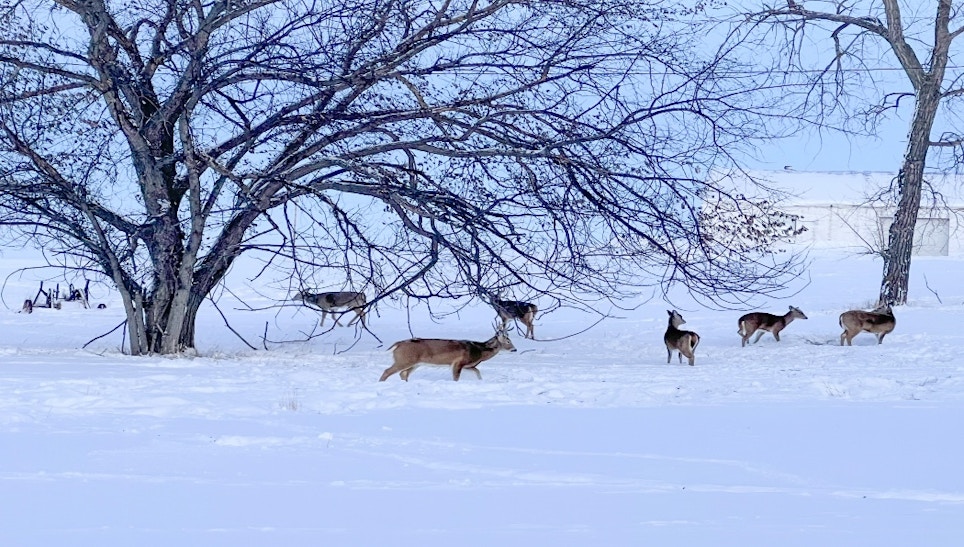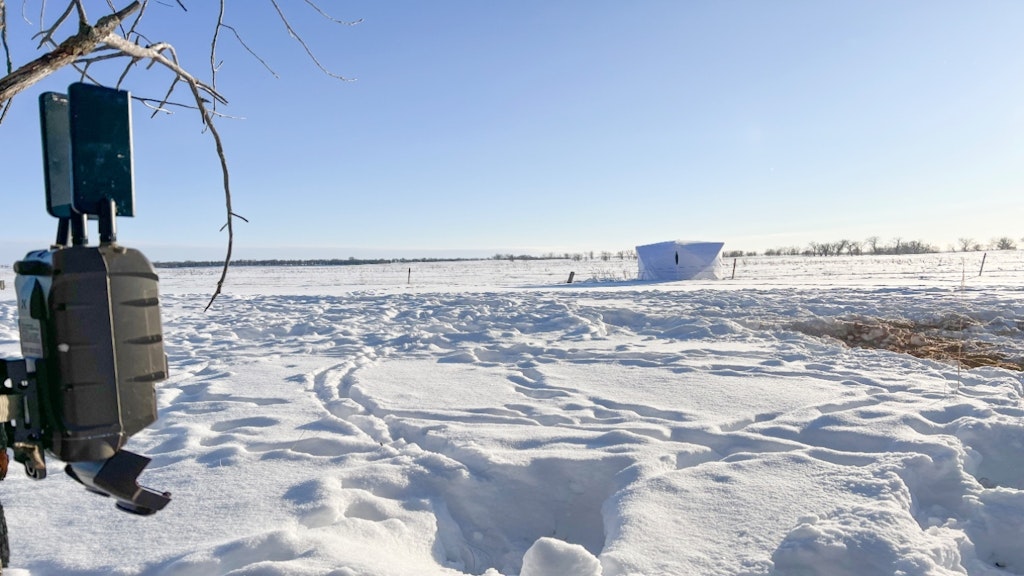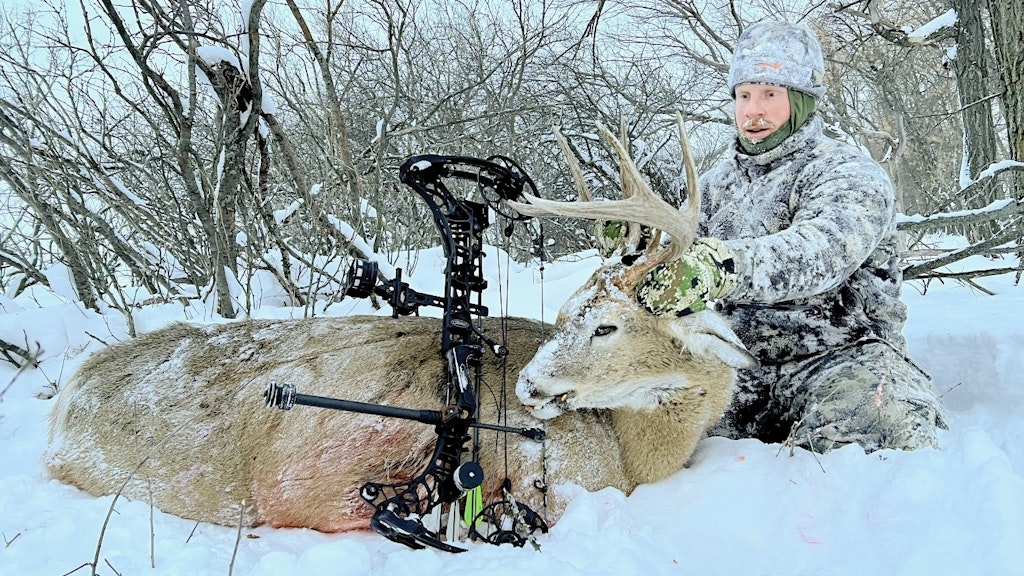North Dakota. It’s perhaps the most punishing of proving grounds for late-season whitetail bowhunting. As a lifelong Wisconsin resident, I’ve endured the cold my entire life, but only one December bowhunt in Nebraska compares to the conditions I bowhunted in as Winter Storm Diaz’s tailwinds swept subzero temps across North Dakota’s plains.
The thermometer never read higher than 0°F during the 5 days I battled the North Dakota cold and deep, drifted snow. I felt instant pain whenever I stepped outside the motel or hopped out of my pickup, and wading through knee- and hip-deep snow was common. With even colder temps and higher winds incoming, my trip was being cut short; I could hunt just one more afternoon and then head home to avoid I-94’s icy, drifted lanes and the inevitable Christmas-traffic onslaught.
My HuntStand app painted as ideal a picture as possible for my final hunt: northwest winds, light snowfall and temps plummeting to -25°F (not figuring the windchill). To clarify, it was ideal for deer movement, but not so ideal for sitting still for a few hours. But, I had a dandy buck regularly triggering my Cuddeback trail cam — I’m surprised it worked in the cold — which stoked my fire.
I began perspiring following my 600-yard walk to my blind that afternoon. Inside the blind, I peeled off my parka so that the steam could evaporate rather than soak my layers. The steam rolled off, and as soon as my sweat had vaporized, I put the parka back on and got everything ready, my face decorated with icicles.
Deer began appearing at about 4 p.m. I dug my camera battery from my pocket where it had been on a Hot Hands body warmer (the only way to keep it working), slid it into my camera and began recording the action for a YouTube episode of HuntStand’s Whitetail POSSE. The winds were ripping and the temps falling, but I was staying fairly comfortable.
Suddenly, a few different bucks and does became squirrelly; I had an inkling that my buck was coming. Moments later, his enormous body was framed in the blind window. Carefully, I grabbed my bow, hooked up my release and drew, but then he faced directly away from me. I held for nearly a minute before he offered me a 14-yard gimme. My Rage-tipped Easton 6.5 Acu-Carbon sent from my Mathews Phase4 struck perfectly.
Welcome to Late-Season Bowhunting
There probably isn’t a more effective time to hunt big bucks over a food source than during the late season when they’re smoked from the rut. A huge weather event bringing in snow and cold temperatures can put even the oldest, wisest bucks on their feet during shooting light — they’ll die if they don’t eat. So, if you’re packing a buck tag and have access to a killer late-season food source, you could be in for one epic hunt.
Here’s the caveat: Hunting in subzero temperatures complete with biting winds is misery, especially if you don’t have the right gear. I’ve been there and done that. Believe me, it sucks trying to sit until dusk when your toes are numb and you’re shivering one hour into the sit. In North Dakota, I not only survived, but I stayed comfortable enough for the Lord to bless me with a buck that was tooth-aged at 4.5 years old. Here’s how I did it.
The Right Apparel
Whether it’s 30°F or -30°F, core warmth is critical. When the core senses the cold, blood flow to the extremities restricts to prevent heat loss to the vitals. That’s why I cannot stress enough how nice it is to have a heated vest like the one I wore on my hunt — more on that in a minute. It doesn’t mean you can disregard your hands and feet. It just means that keeping your core warm will prevent a blow-flow restriction to the hands and feet, making it easier to keep everything, including the extremities, warm.
It’s long been proven that layering is a crucial step to staying warm. Obviously, apparel constructed of the right materials helps, too. My getup during my subzero bowhunt started with Sitka Gear’s Core Heavyweight base layers and a Core Lightweight Hoody (I wore it solely for the built-in breathable face mask). Over the base layers, I wore a Tidewe heated pant and vest. My outerwear was Sitka Gear’s Fanatic Jacket and Bib. My dexterity was fairly good considering how bundled-up I was, yet slightly limited compared to my November garb due to the heated pieces.
For footwear, I wore Rocky’s BlizzardStalker 1,200-gram insulated boots over two pairs of LaCrosse Footwear socks. That setup alone wouldn’t have kept my feet warm for the 3 hours I hunted had I not stuffed toe warmers inside the boots. If I were to do it over, I’d have Arctic Shield Boot Covers over the Rocky boots. I unsuccessfully tried finding some at a Fleet Farm before the hunt, but that’s beside the point.
My noggin stayed warm inside Sitka’s Fanatic Beanie. When I was hiking, I wore Sitka’s Blizzard GTX Mitten. In the blind, I tucked my hands inside the Fanatic Jacket’s pass-through front pocket where I’d stuffed two large body warmers. In the past, before I owned a heated vest and pant, I always stuffed large body warmers between clothing layers by my lower back, hamstrings and sides. It helps a lot to have heat in key areas, but the challenge is keeping them from shifting out of place.
I have a lot of experience with Sitka Gear, but I know other diehard late-season hunters who depend on other proven brands, including Code of Silence, First Lite, Kings Camo, KUIU and others. YouTube is filled with detailed reviews; watch and learn.
Shot Distance and Ethics
Staying warm is important, but don’t forget that a successful hunt means you’ll have to draw your bow and make a lethal hit while wearing a ton of clothing and after sitting motionless for hours. Restrictive clothing has a bearing on your shooting form and effective range. Although I’d practiced out to 50 yards in my hunting apparel right before the trip, I made 30 yards my limit for the hunt. That’s half the distance I feel confident in shooting during warmer conditions, but I knew it was an ethical decision. You, too, must draw your line in the sand — or snow!
That being said, I worked to craft a setup that would produce such an opportunity. Baiting on private land is legal in the North Dakota unit I was hunting. I’m not a big fan of bait hunting. Besides this buck, I’ve taken only one other buck over bait in 20-some years of hunting, and that buck was also taken during a cold, late-season North Dakota hunt.
Anyway, I wanted a 20-yard-or-less shot, and I chose baiting as my ploy to orchestrate such an opportunity. Familiar with a piece of public land where deer love to bed, I asked for permission to hunt the fringe on some private land and got it. That enabled me to place a legal bait within top-pin distance of a blind I set downwind from it.
Final Thoughts
There’s one more element to subzero hunting that isn’t often discussed. Hunting alone as I was in North Dakota when it was -40°F with the windchill factor is a matter of life and death. That’s one reason why I hunted from a blind and not a treestand. I also stayed in contact with a local fella and my wife (she was hundreds of miles away), but even then, if I had made one mistake and collapsed out there, I bet I would’ve been a goner before anyone found me. With the drifting, it was practically a whiteout, and the wind was howling so loudly that I bet I couldn’t have heard someone shout from only 30 yards away.
Bowhunting in punishing temps will test you as a bowhunter. But, it’s when big late-season bucks are susceptible in daylight around food sources. So, get out there. Keep someone informed on your status in case misfortune should strike. Wear an appropriate apparel system, set some ethical shot-distance limitations and strive for a top-pin shot. The end result could be a mature buck on the ground as it was for me.
Photos by Darron McDougal








